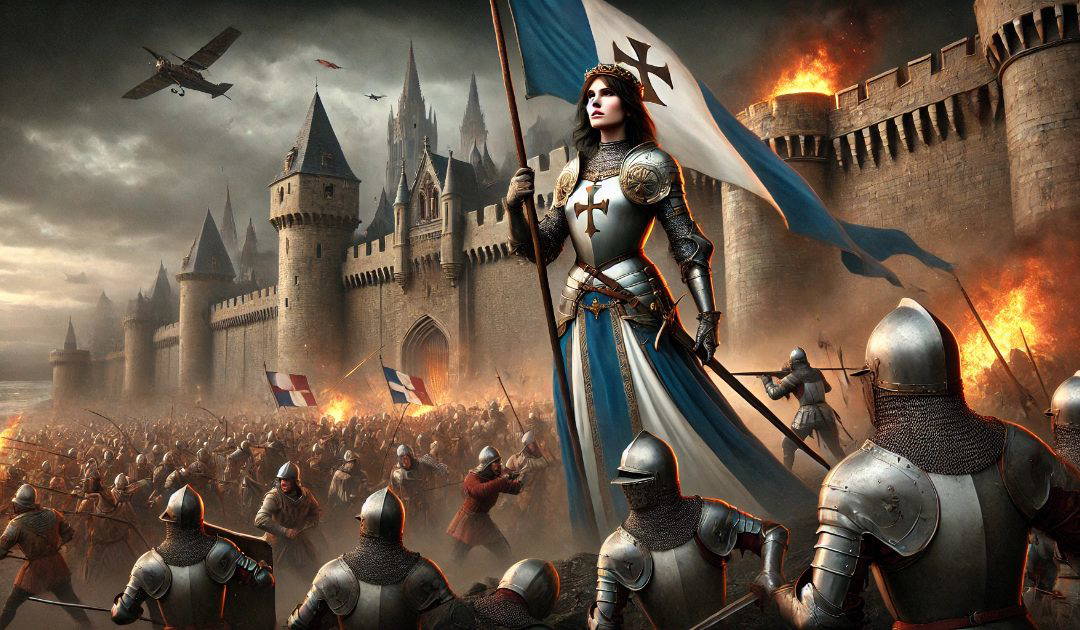On the 29th of April, 1429, Joan of Arc arrived at Orleans to relieve the siege. Unlike Chat GBT, I didn’t realise that they had aircraft back then. What was all that fuss about the Wright Brothers? Anyway, back to the Siege of Orleans.
The 15th century was a pivotal time for Europe, marked by the protracted and tumultuous conflict known as the Hundred Years’ War, which raged between England and France. Among the many significant battles and sieges, the Siege of Orleans stands out as a turning point that altered the course of the war and the fate of France. This monumental event, which took place from 1428 to 1429, witnessed the remarkable rise of Joan of Arc and heralded a new hope for a beleaguered France.
Before delving into the details of the siege itself, it’s important to understand the broader context. By the time the Siege of Orleans began, the English, under the command of King Henry V, had firmly established their presence in northern France. The Treaty of Troyes in 1420 had further solidified their control by recognising Henry V as the heir to the French throne, leaving the legitimate heir, Charles VII, out in the cold. The English, alongside their Allies, the Burgundians, were pressing southwards, with Orleans being a strategic target as it was vital for controlling the Loire River and hence the heart of France.
The siege commenced in October 1428, with English forces led by Thomas Montacute, the Earl of Salisbury. Orleans was of immense strategic importance, and its capture was crucial for the English ambitions to conquer southern France. The English forces, well-prepared and fortified, started encircling the city, cutting off supplies and reinforcement routes, aiming to starve the city into submission.
The French defenders, under the leadership of Jean de Dunois, the Bastard of Orleans, were determined to resist. Yet, the morale was low, and resources were dwindling. The French forces were fragmented and disorganised, making it difficult to mount a coordinated resistance against the well-disciplined English troops.
In the midst of despair, hope arrived in the form of a young peasant girl, Joan of Arc. Born in Domrémy, Joan claimed to have received visions and guidance from saints instructing her to support Charles VII and liberate France from English control. With her unwavering faith and conviction, she was able to convince Charles to allow her to accompany an army to Orleans.
Joan’s presence reinvigorated the beleaguered French troops. Her charismatic leadership and spiritual fervour galvanised the soldiers and instilled a renewed sense of purpose. Arriving at Orleans in April 1429, Joan quickly took charge, bringing much-needed supplies and reinforcements and instigating aggressive counterattacks against the English forces.
Joan’s influence was nothing short of transformative. Under her leadership, the French launched several assaults on English strongholds surrounding the city. The turning point came on the 7th of May, 1429, with the Battle of the Fort of Les Tourelles. Joan led the charge, rallying her troops with an inspiring mix of tenacity and piety. The French forces, emboldened by her presence, were able to capture the fort, dealing a significant blow to the English siege efforts.
The capture of Les Tourelles marked the beginning of the end for the English siege. Faced with an increasingly emboldened French opposition and mounting casualties, the English forces, now without the leadership of the recently fallen Earl of Salisbury, found themselves in disarray. On the 8th of May, 1429, the English were forced to retreat, lifting the siege and marking a significant victory for Joan and her compatriots.
The lifting of the Siege of Orleans was a decisive moment in the Hundred Years’ War. It turned the tide in favour of the French, boosting the morale of the entire nation and solidifying Joan of Arc’s place as a national hero. Following the siege, Charles VII was able to consolidate his position, eventually being crowned as the rightful King of France.
The events at Orleans marked the beginning of a series of French victories that would ultimately lead to the end of English ambitions in France. Joan’s role in this victory cannot be understated. While she would later be captured and martyred, her legacy endured, symbolising the resilience and perseverance of the French people.

